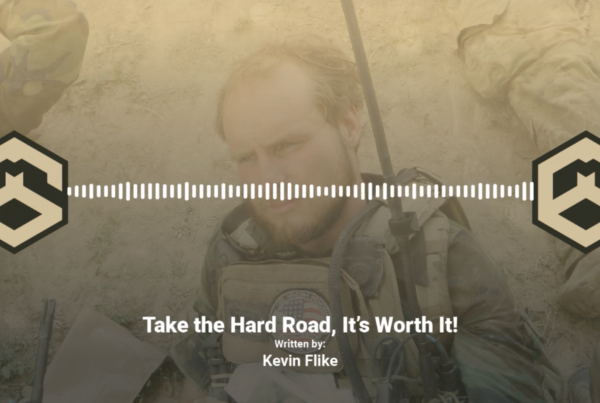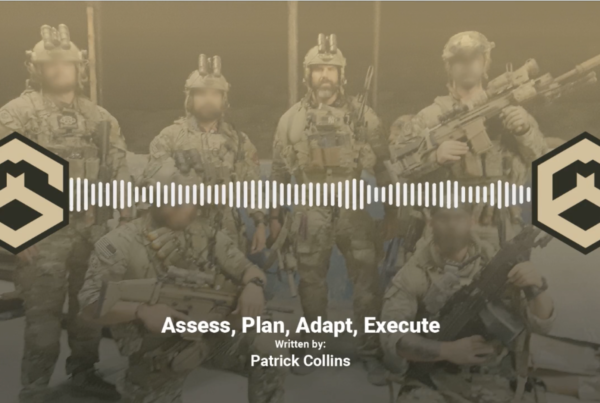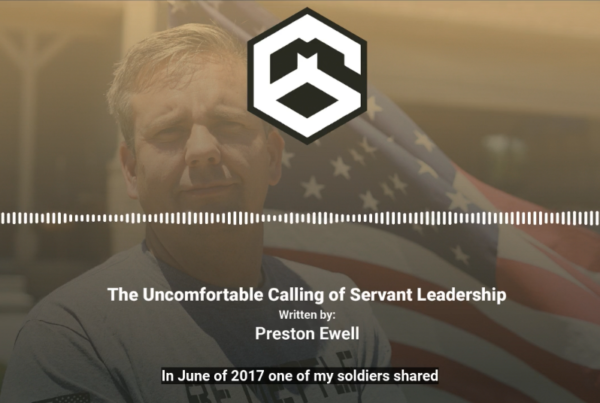In April of 2006, I walked into the team room of Special Forces (SF) Operational Detachment Alpha 092 for the first time, looking for the desk of my new Team Sergeant. I had graduated from the Special Forces Qualification course about six weeks earlier and had been working in the 10th Group communications support shed. My job was to refresh and retrain on the multiple radio systems I would be using whenever I would finally be assigned to a team.
I was excited and a little apprehensive, as I had been told 092 had recently returned from a particularly active deployment in Iraq. They had been under constant enemy contact at one point for over 100 consecutive days. As I entered the cramped room, it was hard not to notice the massive shark jawbone hanging on the wall. Next to it, was a 16” x 20” framed photo of the recently deceased team sergeant, Kelly Hornbeck. A well respected, fearless and experienced leader in 10th Special Forces Group, Kelly had been killed by a road-side bomb just a few months prior. The team had also lost their warrant officer, who had died shortly after returning to the states. The senior medic was cleaning out his locker and was leaving to serve time on the B team. The outgoing senior communications sergeant was packing up his personal equipment and getting ready to attend Ranger school. A few members of the team sat around on couches and folding chairs, dressed in civilian spring weather clothes, wearing tattered baseball hats and watching ESPN news on a small TV placed in the corner.
“You must be Whitt” said my team sergeant, Master Sergeant (MSG) Ball. I walked up the metal stairs to his desk and he told me to sit. He leaned in for a brief handshake. He was down to business, curt, not friendly, and seemed slightly annoyed by the circumstances. “Welcome to 92,” he formally stated. “So, you’re my new Echo, and you had better be a quick learner.” (I was starting to piece together the situation, and knew I was going to be the senior communications sergeant immediately). “First of all,” he continued,w
“I don’t care about any of your bullshit Qualifications course stories, I don’t care how many degrees you have, or what you did before the Army, because none of that matters. Your job is making commo (communications) now. You must be great at it because lives depend on you and how well you do your job. You need to maintain positive control of a whole bunch of expensive shit and know how it works. Then, you must make sure the team knows how to use it. I hear you’re a PT stud and that’s good. Joe is downstairs and he will brief you on your necessary tasks before he leaves us. Now, what are your questions?”
I thought for a second as I looked at MSG Ball, he was in no mood for chatty bullshit. “No questions yet Mass-Sarnt,” I slurred (SF guys rarely pronounced complete rank). He nodded and said, “Oh yeah, read the room, … be seen more than you are heard.”
“READ THE ROOM” resonated with me. This team had been through the whole combat ringer. They had witnessed one of their own, their leader, their brother, die a violent death. The senior medic who was heading to the B team had kept him alive for as long as possible during his transport to the nearest hospital. As I witnessed him zipping up his gear bags, and packing away the remnants of his locker, I didn’t know at the time that he was afflicted with permanent psychological scars. They had lost another leader to tragic circumstances at home. The men in that room had seen members of other teams and attached support soldiers killed and gravely wounded in action. They had taken many lives themselves. They were cynical, passionate, guarded, close knit, profane, experienced, and could accurately read a man’s soul in a few moments. After I introduced myself to the out-going commo sergeant, Joe, he led me to the small communications storage area located in a stuffed closet. Approaching the door, I quickly glanced around the team room. A couple of guys with beards peered at me and nodded their heads before returning their eyes to the TV. The rest of them didn’t even look my way. I realized that fitting into this team would be one of the great challenges of my life.
Before we even started talking about the communications equipment, Joe gave me a quick rundown of team 092. What made the team tick, what the eleven guy’s personalities were like, and what would be expected of me in the short and long term. As I drove back to my apartment, I thought about all those dudes in that room, and wondered how will I stack up? I was 34 years old, had not seen any combat, was the newest guy on the team, and already appointed the senior communications sergeant. I had to show up at 6:00 AM the following morning to swim 1000 meters with them at a local YMCA. I had not swum in a pool in well over a year. I had to prove my worth as a teammate quickly. I had heard stories of how any display of incompetence would lead a poor schmuck to being jettisoned out the team-room door and stuck in the commo shed until his enlistment ran out. My mind was RACING.
I was a strength and conditioning coach for nine years before I joined the United States Army. I proudly served six years, then resumed my career in the Strength coaching industry in 2009. I wish I could say that I was a perfect SF teammate, but I was not. Due to my background, I probably misconstrued the importance of physical fitness over consistent proficiency with the ever-changing technology of radios and computers. I didn’t make the Special Forces my career path, as many others had chosen to do. However, being told to “read the room” influenced me, and it helped me become accepted, and become a contributing member of an important team performing asymmetrical warfare in a foreign land. READ THE ROOM has also had a positive effect as I returned to the coaching profession. Why is that?
Seeing those men in their post-deployment condition back in 2006 gave me a focused sense of mission and intense level of urgency. I quickly and unconsciously felt EMPATHY for my teammates.
It would be easy to write an article and bullet point a whole list of traits needed to become a better teammate. Whether you are a coach, player, a CEO, a sales executive, or a construction manager, you will depend on the inner workings of others to be successful. Wouldn’t it be great if you could just run down a checklist with someone before you hire them and make sure they are a “Team Player?”
- Do you put the needs of the team before yourself?
- Do you work well with others, and seek ways to help them accomplish a task?
- Do you receive instructions and dutifully follow them until the job is done?
- Do you think about how your words and actions will affect your teammates?
Blah, Blah, Blah…good luck with that. Everyone will check “yes”. Nobody will admit that they are a poor teammate. But before you can even begin to be a contributing, selfless, and compelled teammate, you MUST possess that almost unobtainable quality of EMPATHY. Empathy means putting others’ needs ahead of your own, understanding their human condition, their emotions, and their thought processes before you talk, act, or retaliate.
We are living in a world devoid of empathy.
The music pumping through millions of earbuds these days stresses vindictiveness, retaliation, gaining personal riches, abusing others for personal or sexual gain, and glorification of criminality. Our movies and video games are much the same way. We have two or three thousand Facebook “friends” but don’t really know any of them. We are connected technologically but not truly connected socially or intimately at any level. Look around a crowded airport or restaurant, and see how many people are interacting socially, and how many have their face buried in their phone? Over the course of time, are we bonding to one another like humans in the past, or primarily keeping up with our social media presence?
Dr. Douglas Labier is a business psychologist and psychotherapist that works as the Director of the Center for Progressive Development in Washington DC. The psychology of empathy is a large part of his study and practice. He has labeled the “increasingly polarized social and political culture of the past few years” a result of an overall deficit of empathy in society, even coining the term Empathy Deficit Disorder. He has identified many signs of those who chronically lack empathy.
- They quickly criticize others without understanding their situation.
- They are out of touch with those who are suffering or who are less fortunate.
- They believe they are right, and whoever feels differently than them are wholly ignorant.
- They have a hard time making and keeping friends.
- They are not close with their family members.
- They are happy with receiving favors from others without showing appreciation and will not return the favor. (Labier, 2018).
Let’s take the example of a football team with over 100 players, and most of them exhibit two or more of these traits. It would be a great challenge to get this team to work together, trust one another, play hard for one another, and win.
Do some self-reflection here. Do any of these traits seem familiar, within yourself or with members of your team? The urge to criticize others without remorse is perhaps the reason why online and actual bullying is so prevalent today.
Tactics to Foster Empathy/Chemistry
WORK HARD TOGETHER-There’s no greater bond than one forged by shared misery
Here are a few tactics to work on the development of empathy in your group-in these examples it’s a football team during their offseason. An effective manager of a business can be creative and apply these methods in group activities like hiking, river trips, confidence courses, or any other outdoor adventure “get-away.” Any activity that involves inconvenience, teamwork and varied levels of stress can create bonding and group empathy towards one another.
FINISH DRILLS-At the conclusion of every workout at every place I’ve ever coached, we perform group “finishing” drills. These finishers may include:
- Group 45lb plate front raises, overhead press, plate curls, or holding the plate overhead for time. If one player fails? Prolong the repetitions.
- Two athletes, standing side by side sharing a loaded bar, performing overhead press, curls, or overhead bar holds for time. Last team holding the bar without dropping out wins
- Group core stability, requiring them to hold various “plank” positions on their elbows and toes for time. If one player fails? Prolong the time standard.
- Mutual respect can be garnered by witnessing individual exertion and effort.
A TEAM THAT SQUATS TOGETHER WINS TOGETHER
- Over the course of three to four weeks, work up to a team squat workout of 8 sets of 8 reps at around 60-70% of their max. It is important to spend a few weeks acclimatizing your team to this upcoming volume training session. Include strict time standards such as 2 minutes or less between sets, with teams of 2-3 squatting at the same station. This will involve rapid weight changing and communication. The last group to finish each set must perform 3-5 burpees. If one athlete does not squat to proper depth, the ENTIRE ROOM must start that set over again.
- This workout will create a stressful environment and give athletes an opportunity to display leadership and grit. Uncommitted teammates will also be exposed.
THE LONG MEETING/EDUCATE
- An effective bonding technique is to conduct a series of meetings with your staff or team and educate them on the importance of cohesion and empathy. These meetings must be candid, visceral, and use true-to-life examples of team failures and team successes. Have time set aside for everyone to have between 10-15 minutes to tell their peers about themselves. Here are some good questions to assign everyone.
- Full name, place of birth.
- Mother and Father’s names, sibling’s names, what they do, (or did) and details about their lives. This will sometimes turn dark, and that is ok.
- Why are you here? What are your goals for the team?
- What is the saddest moment in your life? (that one feels comfortable enough discussing)
- What is the happiest moment in your life?
- What aspect of your life are you the proudest of?
- What do you think is the biggest asset you bring to the team?
- What is a bucket list item for you?
These meetings may run long and may get somewhat emotional. I have been on football teams that have taken over two full weeks to complete this teamwork exercise. Take necessary breaks after a couple of people speak. Encourage everyone to listen with respect and stay off their hand-held devices.
This engagement style will go far towards building a better understanding of what makes everyone tick and give a personal glimpse into everyone’s lives. Though not a foolproof method, you will be working on empathy building with these meetings. You will see members of your team laugh and even cry. Varied, honest, emotional stimulations in a group setting will draw people together.
ENCOURAGE DAILY GROUP INTERACTION
The New England Patriots are one of the most successful organizations in all of sports. Since 2001, they have won six Super Bowl Championships. Much of this success can be contributed to the leadership style of Head Coach Bill Belichick. One of the many requirements of his team and coaches is to demand group interaction. With the frenetic pace of roster changes, NFL organizations have little time to create necessary team cohesion, but Coach Belichick has implemented a few strategies to do just that. I had the unique privilege of spending a workweek with the Patriots during a recent off-season and witnessed a few team-bonding strategies.
- They limit distractions– The organization has a rule about the use of hand-held devices. When a player has down time or preparation time in the locker room, they may use their cell phones. However, they are not allowed to use their phone anywhere else in the building. They have a world-class dining facility, and when they eat, they talk to each other. When in team meetings, during injury treatment or weight room sessions, they are not distracted by their hand-held device. If these players that get paid multi-million-dollar contracts can conform to this policy (or get fined if they don’t) then maybe your organization can find a way to get your people to interact with one another.
- They train in organized groups- The offensive linemen worked out at two racks, with five men. They were involved in each other’s work, shouting words of encouragement, or bragging about their workload surpassing their peers.
- They do not wear sunglasses-Yes, can you believe it? Coach Belichick believes that eye to eye contact is essential to human communication. While outside the coaches and players can wear hats to block the sun, but no sunglasses.
READ THE ROOM-The last point focuses on looking outwards from yourself and your own needs. As you enter an organization, or show up for work after having been there a while, think about the following:
- How can I empathize with my co-workers/ teammates?
- What is their back story, and how can understanding that help me get along with them better?
- Do they need help with anything?
- What motivates them to work/train? Is there anything I can do to assist with motivating them?
- What kind of day are they having?
- Is there something going on in their life that is dragging them down? How can I make their situation better?
Conclusion
In the new book DELIBERATE DISCOMFORT released by the leadership-inspired group Mission Six Zero, former Green Beret Jason Van Camp emphasizes the necessity of TRUST in a successful organization. He points to the research performed by Dr. Paul Zak, regarding the hormone Oxytocin. This hormone is released when people bond socially (it is sometimes even called the “love hormone”, which, when released, increases feelings of cohesion amongst small groups) (Pappas, 2015). Dr. Zak discovered through his research that teams with high levels of trust, i.e. Oxytocin, had increased productivity, job performance and felt overall satisfaction in their workplace. It is intriguing to see that modern science directs us to foster trust, and what better way to build trust than gain empathy for one another?
Whether you are a leader in a company or a team, or low on the organizational chart, you can set an example by displaying, and dropping the seeds around for empathy.





